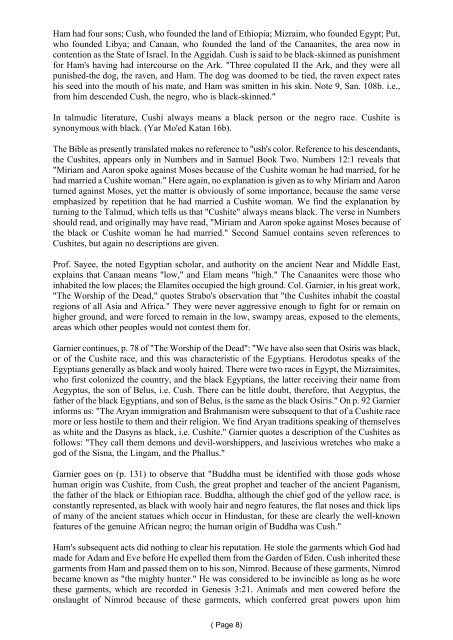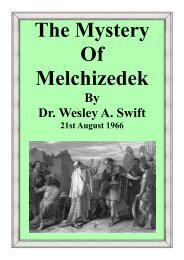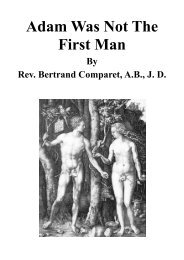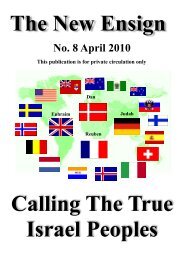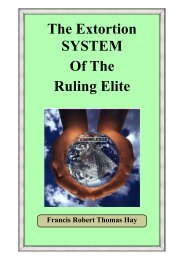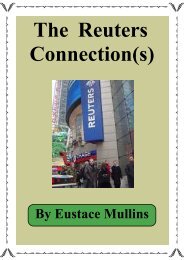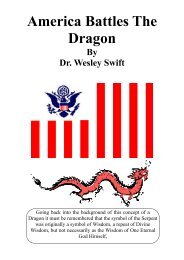Curse of Cannan - The New Ensign
Curse of Cannan - The New Ensign
Curse of Cannan - The New Ensign
You also want an ePaper? Increase the reach of your titles
YUMPU automatically turns print PDFs into web optimized ePapers that Google loves.
Ham had four sons; Cush, who founded the land <strong>of</strong> Ethiopia; Mizraim, who founded Egypt; Put,<br />
who founded Libya; and Canaan, who founded the land <strong>of</strong> the Canaanites, the area now in<br />
contention as the State <strong>of</strong> Israel. In the Aggidah. Cush is said to be black-skinned as punishment<br />
for Ham's having had intercourse on the Ark. "Three copulated II the Ark, and they were all<br />
punished-the dog, the raven, and Ham. <strong>The</strong> dog was doomed to be tied, the raven expect rates<br />
his seed into the mouth <strong>of</strong> his mate, and Ham was smitten in his skin. Note 9, San. 108b. i.e.,<br />
from him descended Cush, the negro, who is black-skinned."<br />
In talmudic literature, Cushi always means a black person or the negro race. Cushite is<br />
synonymous with black. (Yar Mo'ed Katan 16b).<br />
<strong>The</strong> Bible as presently translated makes no reference to "ush's color. Reference to his descendants,<br />
the Cushites, appears only in Numbers and in Samuel Book Two. Numbers 12:1 reveals that<br />
"Miriam and Aaron spoke against Moses because <strong>of</strong> the Cushite woman he had married, for he<br />
had married a Cushite woman." Here again, no explanation is given as to why Miriam and Aaron<br />
turned against Moses, yet the matter is obviously <strong>of</strong> some importance, because the same verse<br />
emphasized by repetition that he had married a Cushite woman. We find the explanation by<br />
turning to the Talmud, which tells us that "Cushite" always means black. <strong>The</strong> verse in Numbers<br />
should read, and originally may have read, "Miriam and Aaron spoke against Moses because <strong>of</strong><br />
the black or Cushite woman he had married." Second Samuel contains seven references to<br />
Cushites, but again no descriptions are given.<br />
Pr<strong>of</strong>. Sayee, the noted Egyptian scholar, and authority on the ancient Near and Middle East,<br />
explains that Canaan means "low," and Elam means "high." <strong>The</strong> Canaanites were those who<br />
inhabited the low places; the Elamites occupied the high ground. Col. Garnier, in his great work,<br />
"<strong>The</strong> Worship <strong>of</strong> the Dead," quotes Strabo's observation that "the Cushites inhabit the coastal<br />
regions <strong>of</strong> all Asia and Africa." <strong>The</strong>y were never aggressive enough to fight for or remain on<br />
higher ground, and were forced to remain in the low, swampy areas, exposed to the elements,<br />
areas which other peoples would not contest them for.<br />
Garnier continues, p. 78 <strong>of</strong> "<strong>The</strong> Worship <strong>of</strong> the Dead": "We have also seen that Osiris was black,<br />
or <strong>of</strong> the Cushite race, and this was characteristic <strong>of</strong> the Egyptians. Herodotus speaks <strong>of</strong> the<br />
Egyptians generally as black and wooly haired. <strong>The</strong>re were two races in Egypt, the Mizraimites,<br />
who first colonized the country, and the black Egyptians, the latter receiving their name from<br />
Aegyptus, the son <strong>of</strong> Belus, i.e. Cush. <strong>The</strong>re can be little doubt, therefore, that Aegyptus, the<br />
father <strong>of</strong> the black Egyptians, and son <strong>of</strong> Belus, is the same as the black Osiris." On p. 92 Garnier<br />
informs us: "<strong>The</strong> Aryan immigration and Brahmanism were subsequent to that <strong>of</strong> a Cushite race<br />
more or less hostile to them and their religion. We find Aryan traditions speaking <strong>of</strong> themselves<br />
as white and the Dasyns as black, i.e. Cushite." Garnier quotes a description <strong>of</strong> the Cushites as<br />
follows: "<strong>The</strong>y call them demons and devil-worshippers, and lascivious wretches who make a<br />
god <strong>of</strong> the Sisna, the Lingam, and the Phallus."<br />
Garnier goes on (p. 131) to observe that "Buddha must be identified with those gods whose<br />
human origin was Cushite, from Cush, the great prophet and teacher <strong>of</strong> the ancient Paganism,<br />
the father <strong>of</strong> the black or Ethiopian race. Buddha, although the chief god <strong>of</strong> the yellow race, is<br />
constantly represented, as black with wooly hair and negro features, the flat noses and thick lips<br />
<strong>of</strong> many <strong>of</strong> the ancient statues which occur in Hindustan, for these are clearly the well-known<br />
features <strong>of</strong> the genuine African negro; the human origin <strong>of</strong> Buddha was Cush."<br />
Ham's subsequent acts did nothing to clear his reputation. He stole the garments which God had<br />
made for Adam and Eve before He expelled them from the Garden <strong>of</strong> Eden. Cush inherited these<br />
garments from Ham and passed them on to his son, Nimrod. Because <strong>of</strong> these garments, Nimrod<br />
became known as "the mighty hunter." He was considered to be invincible as long as he wore<br />
these garments, which are recorded in Genesis 3:21. Animals and men cowered before the<br />
onslaught <strong>of</strong> Nimrod because <strong>of</strong> these garments, which conferred great powers upon him<br />
( Page 8)


